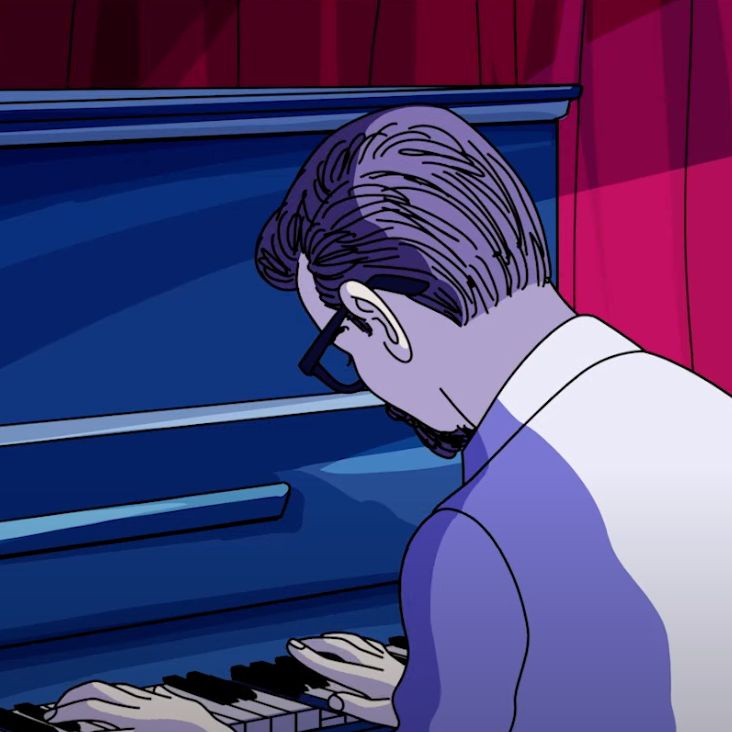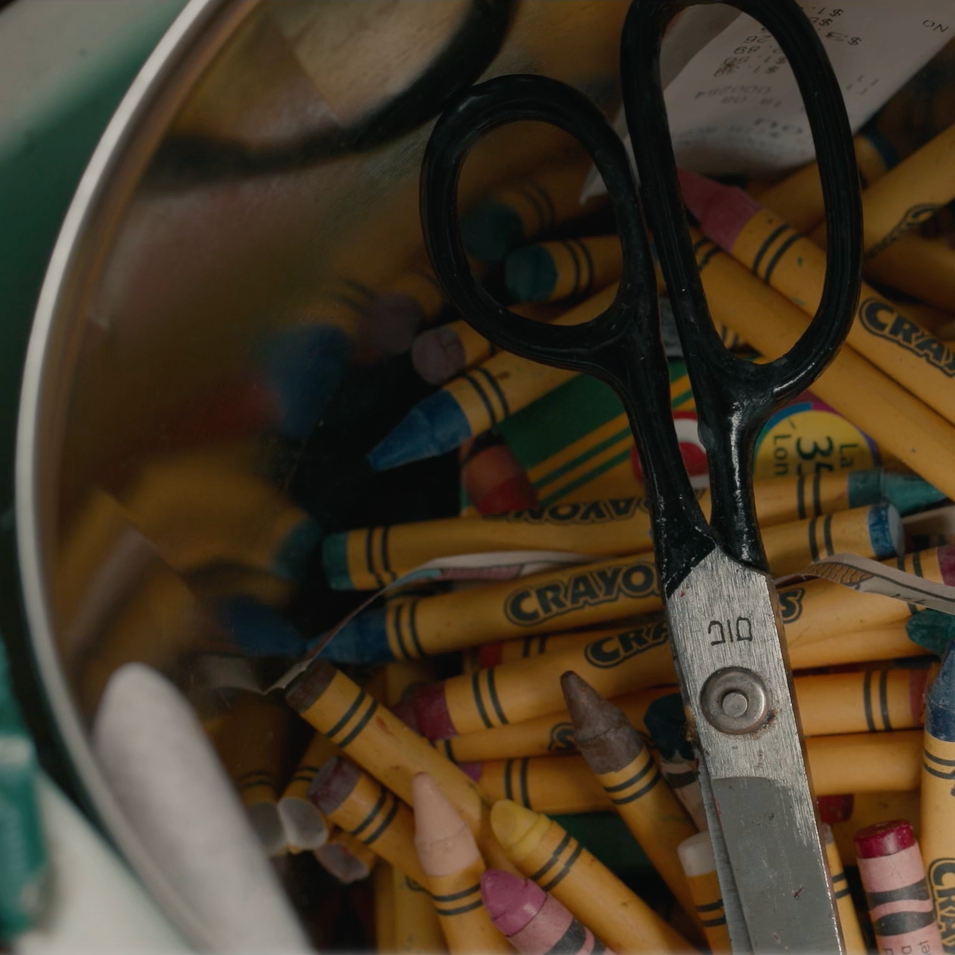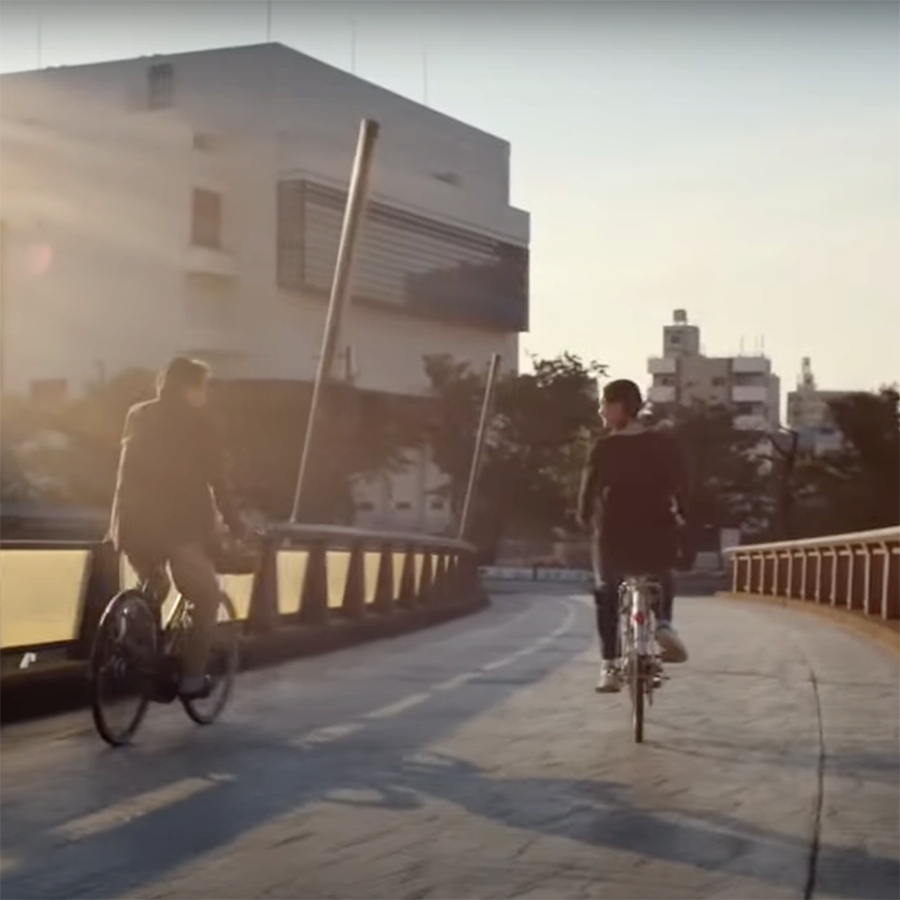
December 18, 2023
Sheffield DocFest 2023: Conflict
The German filmmaker Wim Wenders, best known for features including Paris, Texas, Wings of Desire and The Goalie’s Anxiety at the Penalty Kick also has an extensive documentary roster including Buena Vista Social Club on Cuban music, Pina on dancer Pina Bausch, and The Salt of the Earth on photographer Sebastiao Salgado, has a eponymous foundation to make his life’s work available for free to the public, and to support young talent “to realize innovative and unconventional projects by new means and thus enrich our common visual language.” Coming out of this program is “A Sense of Place,” a collective documentary program where “six Iranian filmmakers tell stories located in Iran or in exile and enter in exchange with the respective places they visit with the project.” Four were shown at Sheffield DocFest this year.

Still from Hollow.
Hollow reflects on the cells that we spend our life and death in — “the troglodyte village of Meymand to a secret police prison turned into a museum, a rectangular pigeon house, to Ekbatan, a high-rise residential complex, [and] ends up into Behesht-e Zahra of Tehran, the largest Cemetery in Iran.” The film opens with a pan across a dwelling carved into a rock face, the stone and mud facade punctuated by wooden doors and window frames. We see an abandoned train car, a desolate cinderblock apartment structure with rectangular openings but no windows and vines growing inside; a Brutalist apartment building in poor shape but with a beautiful curved outdoor staircase; and a circular building with hollow courtyard, looking up to the sky with images of desolate people in grey uniforms — is it a prison? Like a voyeur, we glimpse into the windows of a vast apartment block with identical units. A wall with rectangular indentations is the home to nesting pigeons in the hollows. The film is entirely silent.
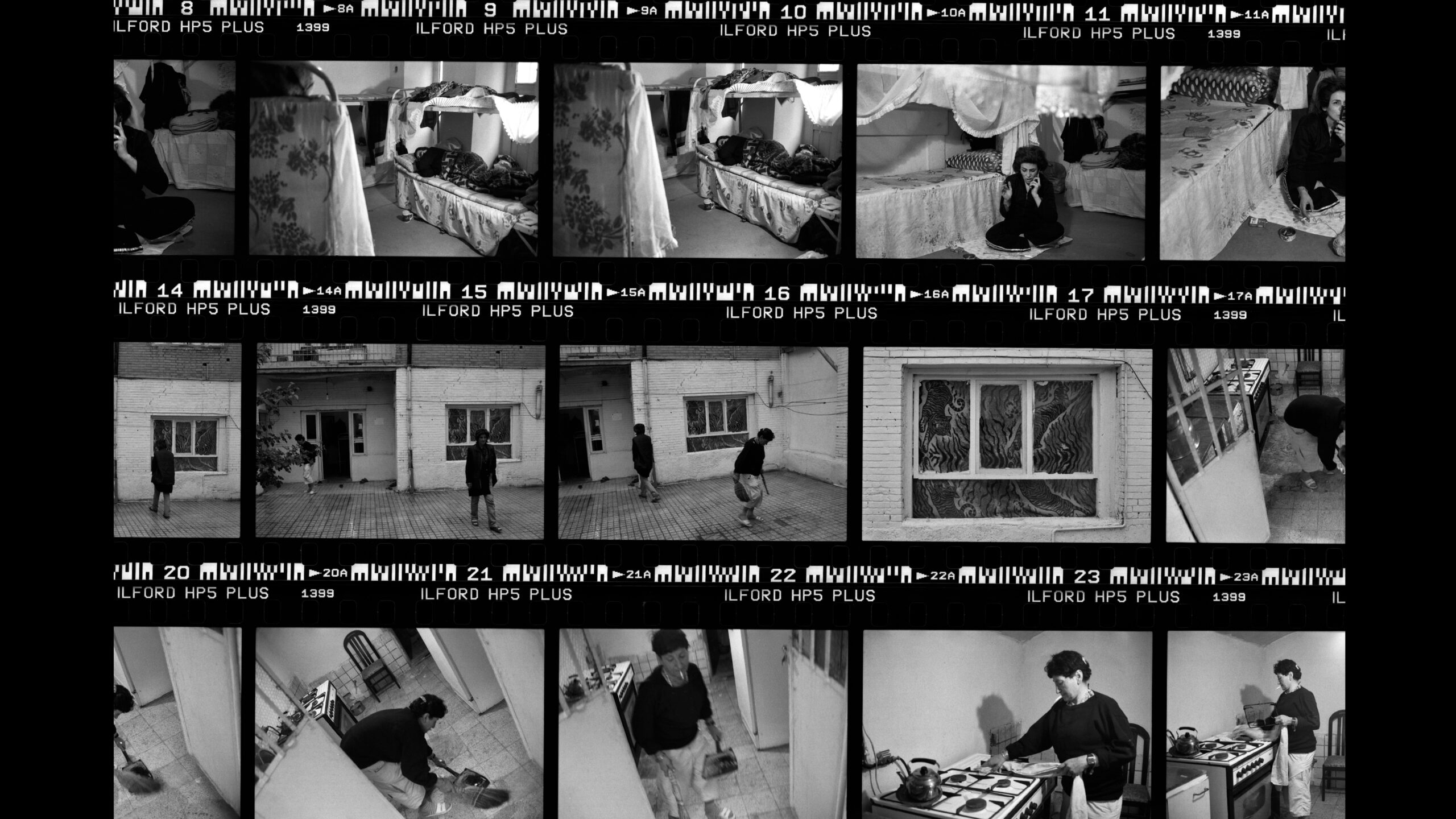
Still from Density of Emptiness.
Similarly, Density of Emptiness deals with the vacuity of spaces, “contrasting images of a women’s shelter with the vast complexes of empty newly-build flats…unbalanced density in the concept of place – the unbalanced division of space in the city of Tehran.” The film opens with a wide shot of the city, then zoom into double towers with cranes in front: “Over there, they have transformed the skyline into lone vertical strongholds. A dense empty mass of steel, stone and concrete.” A grid of towers morphs into a photographic contact sheet with 35mm B&W photos of a bustling life. This is contested with the sterile apartment interiors, a modernist white interior empty of all furnishing, an island kitchen, domed rooms, arched windows, Corinthian columns, mirrored glass, shiny marble floors, skylight light fixtures, washer/dryer. Commentaries include “The space that the rulers of the city entrap by stone and cement, will grow in value with the passing of time. The later a key is turned in the keyhole of this house, the more expensive will its cold and empty space become,” “In the illusion of the rulers, the space of the slopes is like an illegitimate child that must be devoured. Every square meter of land they swallow will hold a treasure,” and “Over there, in the geography of the city, abandoned castles stand like scarecrows, guarding their own emptiness.”

Still from Phobos.
Phobos focuses on the destruction of a city, Bushehr on the Persian Gulf, a target during the Iran-Iraq War of the 1980s, which is the hometown of director, Mina Keshavarz, who imagines getting lost in a place she knows but of which she has nightmarish visions. She walks toward the sea with her body feeling on fire, down empty corridors, forwards and backwards, leading to squares and various buildings, empty food market stalls, empty storefronts, a building with black smoke rising, and broken boats on the shore. “I, home, city, we are burning together.”

Still from Great are the Eyes of a Dead Father.
Great are the Eyes of a Dead Father is the story of Franco-Iranian painter and poet Patrick Navaï, who lives in rural France with his wife and musician son. Their seemingly idyllic life in a medieval village near a vast forest consists of painting, playing music, reading poetry and taking long walks, but masks an unfulfilled desire to know his emigre father’s Iranian life. Audio cassettes labelled “Narration Houcheng,”his father’s Persian name, while he was only allowed to be called Patrick, not Parviz, after his parents made a trip to Iran and his French mother came back disgusted, and Persian was no longer spoken at home. This successful artist who was awarded the Medal of the City of Paris, whose work is in French museums, and is the author of 14 books of poetry, is still longing for a land he never knew.

Still from Carpenter.
Other films at the festival dealt with the impact of war. Carpenter is Hussein Mahmood, a Kurd who crafts false legs for victims of land mine accidents in his native Iran. On in years but still strong and skilled, he goes through the process by himself from start to finish: in the woods, in snow, camping in a tent, he cuts down the logs, hollows out and shapes into prosthetics, largely for older men. It is only at the end that we see that he, too, is an amputee having lost his right foot and lower leg, replaced by one of his own implants.

Still from Three Windows on Southwest.
Three Windows on Southwest recalls the treasured apartment in Kyiv the Ponomarova family moved into in 2002 when they moved from the ground floor up to the 15th, with sunrises on the balcony, and a short hop to the roof. Starting with a photograph of the interior, filmmaker Mariia Ponomarova remembers her life there in three conversations with her mother and two friends. Now, in 2022, smoke from Russian missile targets can be seen behind her building while she begins to reclaim the image of her home.
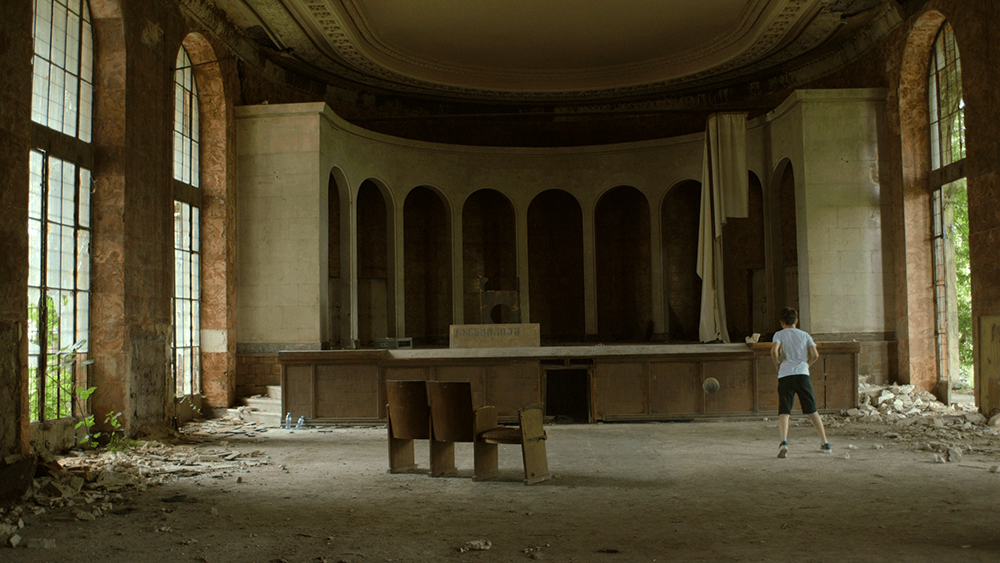
Still from Hotel Metalurg.
Survivors of the Abkhaz-Georgian War where Russian-backed separatists took control of the Georgian province of Abkhazia, fought after the dissolution of the Soviet Union in 1991. Reminiscent of Russia’s claim to Ukraine’s Donbas, the conflict caused many to flee the region with refugees relocating to the town of Tskaltubo, an abandoned tourist resort filled with Soviet-era luxury sanatoriums. Over the last three decades, most of the men have gone, leaving a population of women and children in the hotel which has fallen into disrepair. Hotel Metalurg is one such venue where you can see the former grandeur of the hotel in the big crystal chandelier in the round double-height hall with a grand staircase and large stone columns where a young boy plays ball. One woman hasn’t seen her husband in 11 years, while a toothless old woman says she came from a wealthy family that was ruined by the war. The hotel is now the site for wedding photographs, so we see a parade of bridal parties posing around the romantic ruins. The exterior is still regal with a big windowed vaulted entrance and above it arches and elaborate fenestration under a pediment. The Ministry of the Economy has listed 114 such structures for auction including this one to be refurbished into a luxury hotel, so the residents are being relocated to new council estates, boring cookie-cutter apartments compared to what they have been used to. An elderly bedridden woman says “Russians wage war wherever they go. When have they ever done any good?” while we see the Russian invasions of Ukraine on TV.
Read about outcasts and the arts at the Sheffield DocFest.
Films Mentioned
Hollow, Director Mohammadreza Farzad
Density of Emptiness, Director Shirin Barghnavard
Phobos, Director Mina Keshavarz
Great are the Eyes of a Dead Father, Director Afsaneh Salari
Carpenter, Director Xelil Sehragerd
Three Windows on Southwest, Director Mariia Ponomarova
Hotel Metalurg, Directors George Varsimashvili & Jeanne Noguchi
Observed
View all
Observed
By Susan Morris
Recent Posts
Minefields and maternity leave: why I fight a system that shuts out women and caregivers Candace Parker & Michael C. Bush on Purpose, Leadership and Meeting the MomentCourtney L. McCluney, PhD|Essays
Rest as reparations: reimagining how we invest in Black women entrepreneurs Food branding without borders: chai, culture, and the politics of packaging
 Susan Morris works across media — film, television, radio, exhibitions, public programs, print, digital media — specializing in the arts and culture with an emphasis on architecture & design as a producer, director, editor, curator and writer. She has worked at Publications: Louise Blouin Media (Editor-in-Chief, Modern Painters), Architect’s Newspaper, Art Newspaper, Artbyte, Documentary, Dwell, Eye, House & Garden, and Design Observer; Foundations: Ford Foundation, NEA, Rockefeller Foundation; Media Production: WNYC/PRI (founding Executive Producer Studio 360), BBC UK, Bravo, IFC, NY Times Television, WNET/Thirteen; Museums & Institutions: Cooper-Hewitt National Design Museum, J. Paul Getty Trust, International House, Metropolitan Museum of Art, MoMA.
Susan Morris works across media — film, television, radio, exhibitions, public programs, print, digital media — specializing in the arts and culture with an emphasis on architecture & design as a producer, director, editor, curator and writer. She has worked at Publications: Louise Blouin Media (Editor-in-Chief, Modern Painters), Architect’s Newspaper, Art Newspaper, Artbyte, Documentary, Dwell, Eye, House & Garden, and Design Observer; Foundations: Ford Foundation, NEA, Rockefeller Foundation; Media Production: WNYC/PRI (founding Executive Producer Studio 360), BBC UK, Bravo, IFC, NY Times Television, WNET/Thirteen; Museums & Institutions: Cooper-Hewitt National Design Museum, J. Paul Getty Trust, International House, Metropolitan Museum of Art, MoMA.
